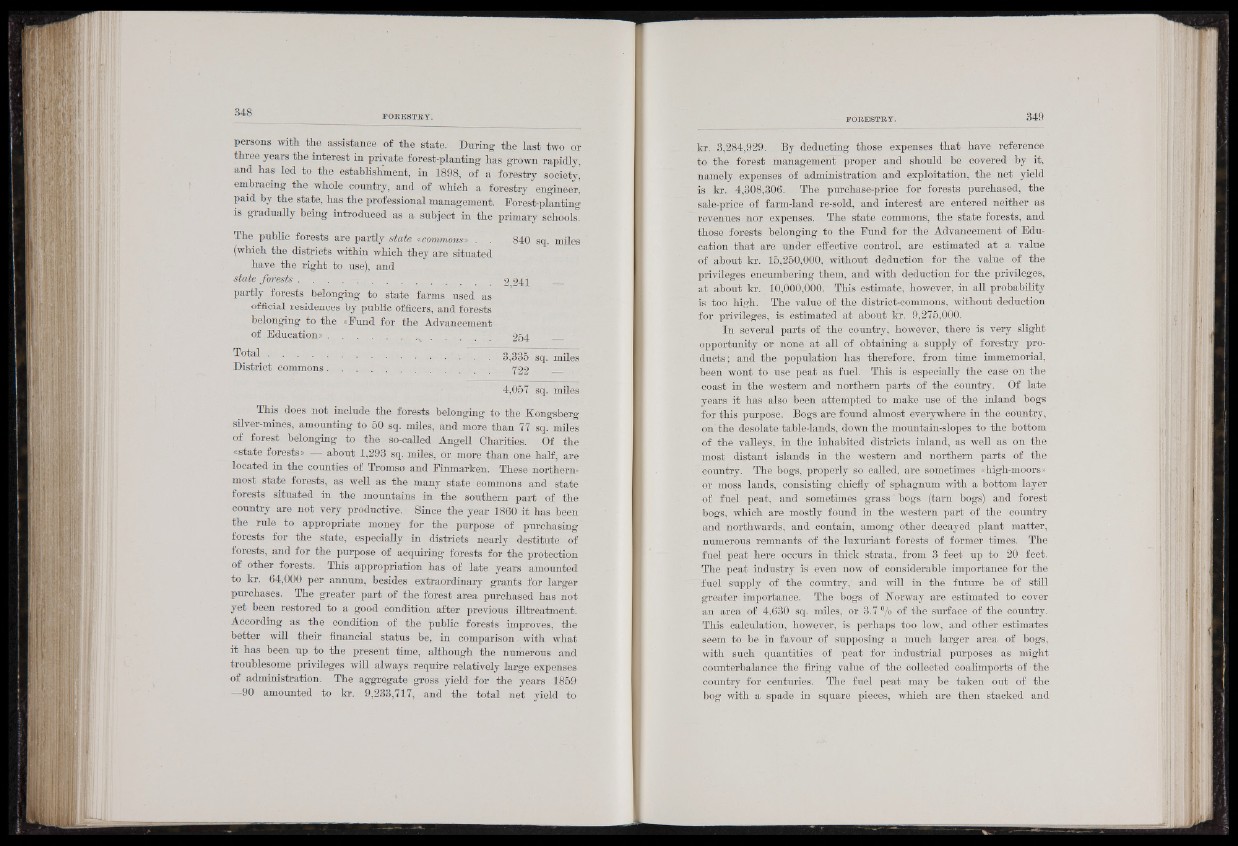
persons with, the assistance of the state. During the last two or
three years the interest in private forest-planting has grown rapidly,
and has led to the establishment, in 1898, of a . forestry society,
embracing the whole country, and of which a forestry engineer’
paid by the state, has the professional management. Forest-planting
is gradually being introduced as a subject in the primary schools^
The public forests are partly state «commons» . . 840 sq. miles
(which the districts within which they are situated
have the right to use), a n d
state forests.................................................................. 2 241
partly forests belonging to state farms used as
official residences by public officers, and forests
belonging to the «Fund for the Advancement
of Education».............................. 254
3,335 sq. miles
722 - ^ 5 .'
4,057 sq. miles
Total . . . .
District commons
This does not include the forests belonging to the Kongsberg
silver-mines, amounting to 50 sq. miles, and more tfia.n 77 gq. miles
of forest belonging to the so-called Angell Charities. Of the
«state forests» — about 1,293 sq. miles, or more than one half, are
located in the counties of Tromso and Finmarken. These northernmost
state forests, as well as the many state commons and state
forests situated in the mountains in the southern part of the
country are not very productive. Since the year 1860 it has been
the rule to appropriate money for the purpose of purchasing
forests for the state, especially in districts nearly destitute of
forests, and for the purpose of acquiring forests for the protection
of other forests. This appropriation has of late years amounted
to kr. 64,000 per annum, besides extraordinary grants for larger
purchases. The greater part of the forest area purchased has not
yet been restored to a good condition after previous illtreatment.
According as the condition of the public forests improves, the
better will their financial status be, in comparison with what
it has been up to the present time, although the numerous and
troublesome privileges will always require relatively large expenses
of administration. The aggregate gross yield for the years 1859
—90 amounted to kr. 9,233,717, and the total net yield to
kr. 3,284,929. By deducting those expenses that have reference
to the forest management proper and should be covered by it,
namely expenses of administration and exploitation, the net yield
is kr. 4,308,306. The purchase-price for forests purchased, the
sale-price of farm-land re-sold, and interest are entered neither as
revenues nor expenses, The state commons, the state forests, and
those forests belonging to the Fund for the Advancement of Education
that are under effective control, are estimated at a value
of about kr. 15,250,000, without deduction for the value of the
privileges encumbering them, and with deduction for the privileges,
at about kr. 10,000,000. This estimate, however, in all probability
is too high. The value of the district-commons, without deduction
for privileges, is.estimated at about kr. 9,275,000.
In several parts of the country, however, there is very slight
opportunity or none at all of obtaining a supply of forestry products;
and the population has therefore, from time immemorial,
been wont to use peat as fuel. This is especially the case on the
coast in the western and northern parts of the country. Of late
years it has also been attempted to make use of the inland bogs
for this purpose. Bogs are found almost everywhere in the country,
on the desolate table-lands, down the mountain-slopes to the bottom
of the valleys, in the inhabited districts inland, as well as on the
most distant islands in the western and northern parts of the
country. The bogs, properly so called, are sometimes «high-moors»
or moss lands, consisting chiefly of sphagnum with a bottom layer
of fuel peat, and sometimes grass bogs (tarn bogs) and forest
bogs, which are mostly found in the western part of the country
and northwards, and contain, among other decayed plant matter,
numerous remnants of the luxuriant forests of former times. The
fuel peat here occurs in thick strata, from 3 feet up to 20 feet.
The peat industry is even now of considerable importance for the
fuel supply of the country,' and will in the future be of still
greater importance. The bogs of Norway are estimated to cover
an area of 4,630 sq. miles, or 3.7 % of the surface of the country.
This calculation, however, is perhaps too low, and other estimates
seem to be in favour of supposing a much larger area of bogs,
with such quantities of peat for industrial purposes as might
counterbalance the firing value of the collected coalimports of the
country for centuries. The fuel peat may be taken out of the
bog with a spade in square pieces, which are then stacked and